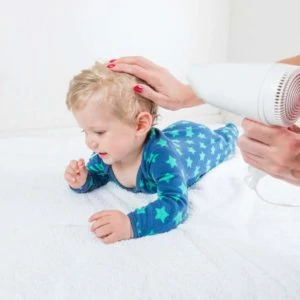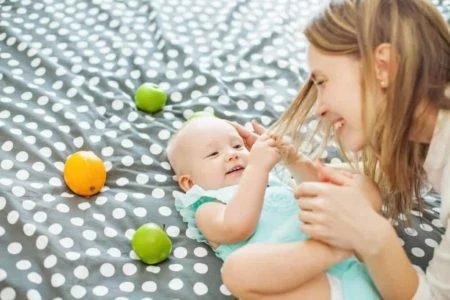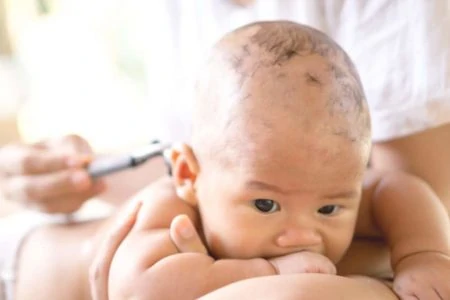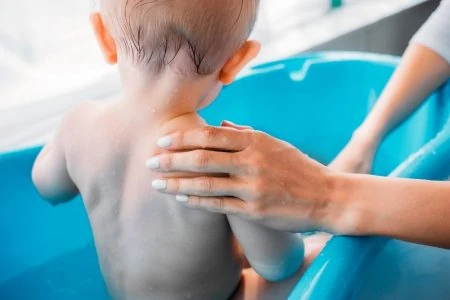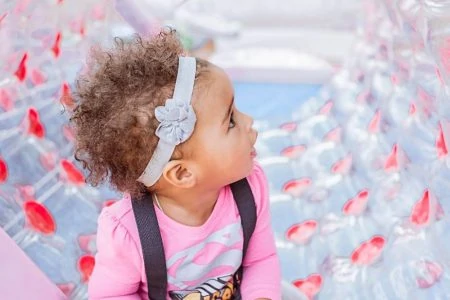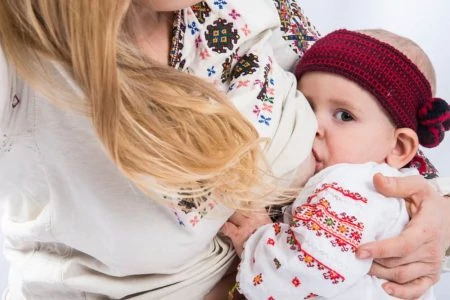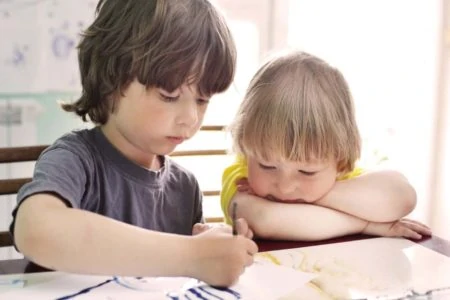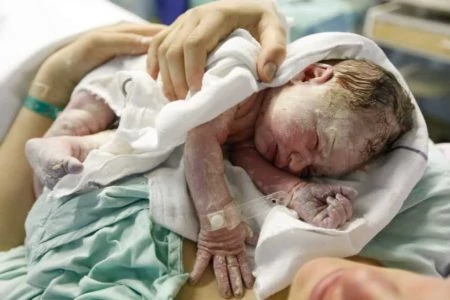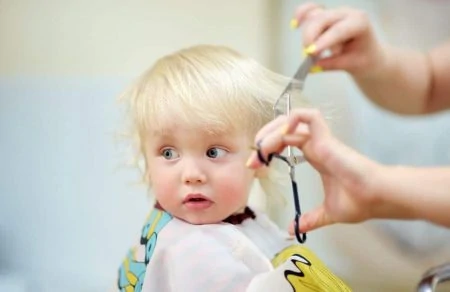Washing your newborn’s hair can feel like a high-stakes mission. Will they cry? Will soap get in their eyes? It is completely normal to feel nervous about handling a slippery, wiggly baby in the tub.
We have been there, and we are here to help. We created this guide to break the process down into simple, tear-free steps.
We will cover when to start, how often to scrub, and the best techniques to keep your little one calm. With a few easy tips, shampoo night might just become your favorite bonding moment.
Key Takeaways
- Timing matters: Wait at least 24 hours after birth to bathe your baby, then wash hair 1-2 times a week.
- Health benefits: Regular washing helps prevent cradle cap, ringworm, and dandruff.
- The right gear: Use a tear-free, baby-safe shampoo and a soft washcloth or cup for rinsing.
- Drying tips: Pat dry with a soft towel or use a soft brush; avoid hot blow-dryers.
When Can I Start Washing My Baby’s Hair?
While you technically can wash your baby’s hair shortly after birth, current guidelines suggest waiting a bit. The World Health Organization recommends delaying the first bath for at least 24 hours. This allows the vernix caseosa (that white, waxy substance) to moisturize and protect their skin.
Once you are home, remember that newborns do not need a daily bath. Washing their hair once or twice a week is plenty (1). Even if your baby is bald, gently washing the scalp removes excess oil and dead skin cells.
If your baby spits up or gets messy in between baths, you don’t need a full tub session. Simply use a damp washcloth to gently wipe their head clean.
When parents inquire about washing their infants’ hair, I recommend they simply rinse the scalp during the baby’s bath. If there are no scalp problems, there is no need to wash with shampoo daily. For infants who are lucky enough to have a full head of hair at birth, it’s OK to use a tear-free infant shampoo up to a couple of times a week.
Editor's Note:
Dr. Leah Alexander, MD, FAAPCradle Cap: Can Regular Washing Help?
Infantile seborrheic dermatitis, or cradle cap, is a common condition that looks like dandruff or thick, yellow scales. It is not contagious, it is not caused by poor hygiene, and it usually bothers parents more than the baby.
Doctors aren’t 100% sure what causes it. Some studies point to maternal hormones stimulating oil glands, while others suggest a yeast called “Malassezia” growing in the sebum (2).
Regardless of the cause, regular washing can help. Keeping the scalp clean removes excess oils that contribute to the buildup.
Because cradle cap is an oily type of rash, I do not recommend using oils to treat it. I commonly discuss this issue in practice and often hear of a grandmother or extended relative who has urged the parents to put oil on the scalp. Unfortunately, once the oil is absorbed into the pores of the scalp, the flaking increases.Instead, I suggest using the “Classic” form of Head & Shoulders shampoo (as opposed to the many other versions available on the market) to wash the scalp every other day for one week. This is easiest to do with the infant lying on their back but inclined a bit so the shampoo does not end up in their eyes. Rinse by pouring water from behind the infant’s head to avoid their eyes as well.
Editor's Note:
Dr. Leah Alexander, MD, FAAPTo treat it, massage a little baby oil or petroleum jelly onto the patches to soften the scales before the bath. Then, gently loosen the flakes with a soft brush while you shampoo.
Benefits of Washing Your Baby’s Hair
Beyond just smelling fresh, keeping your baby’s scalp clean has a few health perks.
1. Could Prevent Ringworm
Ringworm isn’t actually a worm; it is a fungal infection. It appears as a ring-shaped, red, itchy rash and is highly contagious. While your pediatrician might prescribe an antifungal cream to treat it, regular scalp washing can help wash away the fungi that cause it (3).
2. May Prevent Dandruff
Dandruff looks similar to cradle cap but can be itchier. It is often caused by:
- Eczema.
- Excess oil production.
- Dry scalp.
- Fungal overgrowth.
Regular washing with a moisturizing shampoo balances the scalp’s condition. However, if your baby has eczema, check with your pediatrician first. They might recommend a specialized emollient shampoo to avoid irritation (4).
How to Wash Your Baby’s Hair
Ready to scrub? Here is our foolproof method for a clean baby and zero tears.
Gather these supplies before you start:
- A tub, basin, or clean sink.
- A hooded towel.
- A soft washcloth.
- A gentle, tear-free shampoo.
- Optional: A rinse cup.
1. Fill the Tub
Fill your basin with two to four inches of warm water. Aim for about 100 degrees Fahrenheit. If you don’t have a thermometer, use your wrist or elbow to test it. It should feel warm, not hot.
2. Wash the Body First
Wash your baby’s body first. Wet hair causes babies to lose body heat quickly, so save the head for last.
3. Shampoo and Rinse
Support your baby’s head and lean them back slightly. Wet the hair with your hand or a cup, ensuring water flows away from the face.
Massage a dime-sized amount of shampoo into their scalp. Do not rub vigorously; a gentle touch is all you need.
To rinse, use your hand to create a barrier along their forehead. Pour water from the front of the head toward the back. If your baby hates pouring water, use a wet washcloth to wipe the soap away gently.
4. Dry and Snuggle
Lift your baby out and immediately wrap them in a towel. Pat the hair dry gently. Don’t rub hard, as this can irritate the hair follicles. Get them dressed quickly and enjoy some post-bath cuddles.
Is It Necessary to Dry Your Baby’s Hair?
Babies lose a significant amount of heat through their heads. If the room is cool, leaving hair wet can make them chilly and uncomfortable.
We recommend drying the hair immediately with a towel. A hooded towel is perfect for this, it covers their wet head while you dry their body, keeping them warm during the transition from tub to changing table.
How to Dry Your Baby’s Hair
If you want to speed up the process, here are the safest methods.
1. Towel Dry
This is the best method for newborns. Simply use a soft towel to pat the scalp. It absorbs moisture without pulling on delicate hair.
2. Use a Soft Brush
If your baby has fine hair, brushing it after towel-drying can help separate strands and speed up air drying. It also increases blood flow to the scalp, which is a nice bonus.
Some of my parents who have infants with course hair will brush the hair with baby lotion to reduce the tangles. If there are signs of cradle cap, I discourage this practice as the excess oil can worsen the condition.
Editor's Note:
Dr. Leah Alexander, MD, FAAP3. Blow-Dry (With Caution)
Some parents use a blow-dryer, but you must be extremely careful. Baby skin burns much faster than adult skin.
If you choose this method, follow these strict safety rules:
- Cool setting only: Never use heat.
- Keep your distance: Hold the dryer at least 12 inches away from the scalp.
- Keep it moving: Don’t focus on one spot. Use a wide, waving motion.
- Protect the ears: The noise can be loud for little ears, so keep the session very short.
